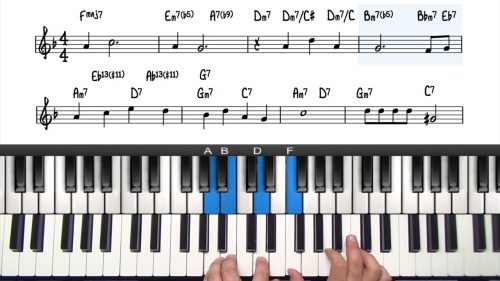“Georgia On My Mind” 7th Chords & Fills
Welcome to this 2nd lesson of “Georgia on my Mind”, for the accompanying pianist, or the singing pianist. In the first video, we familiarised ourselves with the basic melody and harmony, and worked on a simple application of walking bass.
In this lesson we will start with 7th chords, and give a mind to the arrangement.
Introducing Rootless Voicings
After covering the basic 7th chords, we will introduce rootless voicings in our right hand. If you are feeling comfortable at this point, you ca start to be arrangement-minded, deciding what sounds good to you.
We can add as many rootless as you like but also experiment with triads and rooted voicings. There’s no hard and fast rules here other than to see what you like and what adds to the message of the music that you want to communicate.
The Blues-Inspired Introduction
If you are working with a seasoned singer, or if you are performing this song on your own, then you can use an introduction to run some improvised fills using the F Blues Scale and other bluesy embellishments influenced by the great Ray Charles.
Something I like to do for my own arrangement, is to then play the first A up high, rooted and simple, then come down into walking bass for the 2nd A Section.
How To End The Tune
We will add a ‘Trad Jazz’ ending that’s a fairly common device to use in older jazz music. We will explore the ‘Anatole Turnaround’ where we put everything into a full measure, giving our singer tons of space to do their own ending.
Practice Tips
-
To start, let's keep our right hand limited to 7th chords in their rooted position which will help us visualise the important chord tones.
-
This might feel unnatural because there is a lot of jumping around.
-
When we incorporate the inversions, the voice leading will make our arrangement smooth and pleasing.
-
Remember to experiment in the different registers of the piano. Lyndol demonstrates starting the tune high up, and then coming down to make a dramatic climax in the bridge.







Hi Lyndol, you mention the ” dominant” scale at about the 13 minute mark, would this be the V7alt scale ?
Your videos are great, with very useful information
Hi Natasha,
Always wonderful to hear from you. Hope things are going well for you and yours at this time.
So to answer your question, by Dominate Scale I’m actually referring to the Mixolydian scale – the 5th mode of the major scales. It’s exactly the same as the major scale but with a flat 7.
Mixolydian Dominant Scale
1.2.3.4.5.6.b7 For F it would be – F.G.A.Bb.C.D.Eb
So this is a much simpler scale than the V7alt scale. I was using the Dominate (Mixolydian) Scale as a reference to the extended Blues scale which simply adds a b3 to it…
Extended Blues Scale
1.2.b3.3.4.5.6.b7 For F it would be – F.G.Ab.A.Bb.C.D.Eb
Of coarse this is only useful if you know the template for the Dominant (Mixolydian) Scale. Otherwise, the Extended Blues is better thought of in terms of the Major Blues with added 4th (11th) and b7…
Major Blues – (major pentatonic with added b3)
1.2.b3.3.5.6 For F it would be – F.G.Ab.A.C.D
So the extended would just add 4 (11) and b7
Extended Blues Scale (Again)
1.2.b3.3.4.5.6.b7 For F it would be – F.G.Ab.A.Bb.C.D.Eb
Now, the Altered Scale is built off the Dominant Mixolydian as well by keeping the sound defining notes…
1.3.b7
– but altering every other note. I know you know this, but for anyone else reading on…
Altered Dominant
1. b9 .#9. 3. b5. #5. b7 For F it would be – F. Gb. G#(Ab). A. B . C#. Eb
It’s a more sophisticated jazz sound to be sure, but it could work. It all depends on what sound you are going for, what voicings you are using in the left hand and how comfortable you are with that scale.
In the video, I was offering up the Extended blues for a bluesy version. But If you mainly played around on that #9 (which is the same as the b3) to the 3 of the Alt Dom than it could still give you a bluesy feel.
I’m really glad you brought that scale up, cause it’s a great idea to try for this tune. I’m going to play around with it – to get me out of my bluesy box with that tune in particular.
Let me know how it’s sounding for you, if you have time. Also, let me know if you have another further questions about this.
Hope this cleared it up!
-Lyndol
I L.OVE this! Lyndol. I really have enjoyed the lesson very much. I finally am able to play (in slow tempo) Hayden’s arrangement of Georgia and I was planning to record – then I thought it would be awesome to watch the vocal accompaniment version ! This got me very inspired. Tasteful embellishments you played there – and highly impressive singing skills too! Lots of invaluable tips as to how I can approach the accompaniment while singing it. Thank you so much!!! I will have to watch this lesson ‘on repeat-mode’ for now hehe.